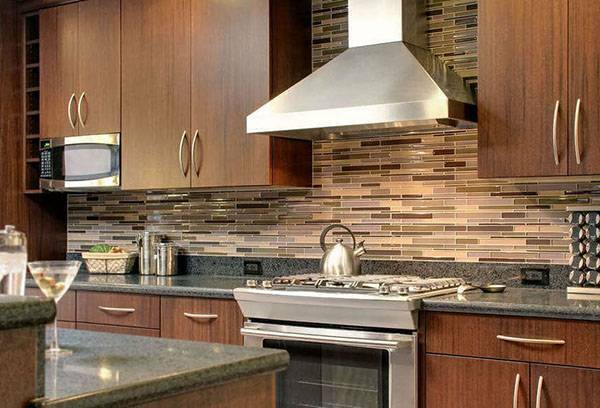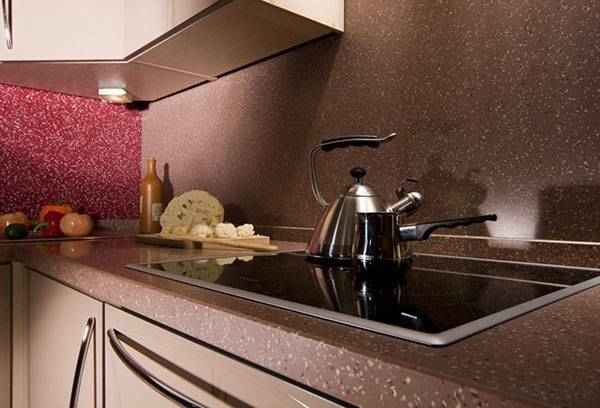- Material for kitchen apron
- Apron made of MDF
- Ceramic tile and porcelain tiles
- Mosaic
- Glass apron
- Natural and artificial stone
- Metal
- Color solution for kitchen apron
The apron at the work surface is an integral parttotal kitchen interior. He simultaneously performs an aesthetic and practical tasks. With its help, designers put emphasis and add a touch to the kitchen.
The main task of the apron is to protect the wall in the places of the most abundant kitchen stains. It must always be located near the hob, washing and in the processing area of the products. Ideally, it is best to have a protective panel along the entire working wall of the kitchen.

Material for kitchen apron
The industry of building and furniture materials offers a lot of variations for the kitchen apron: glass, ceramic, MDF and metal. Determine which option is best, will help brief comparative characteristics of popular materials.

Apron made of MDF( wood-fiber board)
Simple and aesthetic solution. Manufacturers of furniture offer to make a kitchen apron in a harmonious color with the headset. The thickness of the plate can be from 4 to 10 mm.
Advantages of
- Same color of apron and countertop. The interior will have a complete and complete appearance.
- Simple installation. The panel is attached to the wall using liquid nails or kleimers( special metal staples).Before installation, it is not necessary to level the surface.
- Resistant to moisture, high temperatures, mechanical damage.
- Easy to replace with another panel.
- Simple everyday care and minimal amount of stitches.
Disadvantages of
- Short service life.
- May cause fire when contacting an open flame. A kitchen apron made of MDF is not desirable to be installed near a gas stove.
- If replacement of the panel is required, it will be difficult to match the color perfectly.

Ceramic tiles and porcelain stoneware
Few materials can "compete" with the reliability and aesthetics of the tile. It has been very popular for many years and is in no hurry to give up its positions. You can make a choice, stopping at the modern analogue of the tile - porcelain stoneware, which gradually conquers its own "audience of fans".
Advantages of
- Durability.
- Strength. The tile is not afraid of mechanical damage.
- Moisture and heat resistance.
- Simple care. To wash the tile, you can use aggressive detergents.
- A wide variety of color palette, shapes and decorative elements for ceramic tiles.
Disadvantages of
- The laborious process of facing the walls. It is necessary to properly level the surface under the stowage, remove furniture and make a marking for the tile.
- Large number of seams between tiles. They can accumulate fat and dirt, as well as a fungus. To prevent damage and deformation of the seam and the ends of the tile will help a special moisture-resistant grout.

Mosaic
First of all - it's very beautiful. The working wall of the mosaic brings a zest to the interior and attracts the attention of the guests. On the performance characteristics, the mosaic surpasses even ceramic tiles.
Advantages of
- Aesthetics and design. Compositions of any complexity and character are easy to create from a mosaic. The ability to choose any color, texture and shape allows unlimited imagination in the design.
- Strength, moisture resistance and heat resistance is not worse than that of tiles and porcelain stoneware.
Disadvantages of
- Difficulties with leaving. Between the elements of the mosaic there are many seams, which makes it very difficult to clean.
- Tedious and laborious work on laying and preparing the walls of the kitchen.
- Cost of stacking. Lay out the mosaic on the apron is more expensive than the tile, this requires special skills of the master.

Glass apron
Most often in modern interiors use a glass kitchen apron. This is due to the great possibilities of decoration. The surface can be made homogeneous, white, multicolored, to give a matte shade or to put under it any image, photo.
Advantages of
- Seamless surface.
- Simple care. The glass apron is easy to clean with usual detergents.
- Simple installation. You can fix the glass apron on the wall by installing the dowels in the prepared holes.
- The glass apron is not afraid of moisture, high temperatures and scratches.
- Unlimited decoration options - you can use color, photo prints and any other drawings.
Disadvantages of
- The glass apron requires constant care. Even drops of water leave ugly spots on the surface, thus spoiling the aesthetics of the kitchen.
- Cost. Make a glass panel can be made exclusively to order, the production takes place according to special technology and individual parameters of the kitchen.

Natural and artificial stone
Recently, stone surfaces are more and more popular and in demand in the kitchen. The unique color, pattern and natural thoroughness make the room solid and presentable. In addition to aesthetic characteristics, the stone kitchen apron has a long service life and high performance parameters.
Advantages of
- Strength and resistance to moisture and temperatures near the stone is better than other materials.
- Creates a visually homogeneous surface with a countertop.
- Repairability
- Minimum number of joints.
- Durability.
Disadvantages of
- High cost.
- A complex and time-consuming installation.
- Only individual order.
Granite and marble are used to make an apron made of natural stone. They have many basic and auxiliary shades and look great in the interior.
Compared with natural, artificial stone has a lower cost, while maintaining all technical and operational characteristics.

Metal
Modern interior styles( hi-tech, minimalism and others) suggest an abundance of metal surfaces. They bring the motifs of the latest technologies and urbanization into the kitchen interior. As a material, any metal is used: brass, steel, stainless steel or copper.
Advantages of
- Relatively low cost.
- Easy and convenient installation.
- The apron is resistant to moisture, high temperatures and mechanical damage.
- Long service life.
- Aesthetic appearance.
Disadvantages of
- Complicated and time-consuming care. All the dirt is immediately noticeable, the stain remains even from splashing water. To wash such a surface is necessary with the use of special tools and dry with a napkin.

Color solution for kitchen apron
The color of the working wall should fit as best as possible into the style of the kitchen . Which palette to choose depends on the owner's tastes and the overall organization of the space. Perhaps several harmonious combinations of apron and kitchen furniture.

- Contrast
Mainly used in bold and radical styles( hi-tech, minimalism or avant-garde).The color of the apron is chosen as much as possible to the color of the facades. For example, white furniture - a red apron, white working wall and a blue set, and other variations. The result is an accent in the middle of the kitchen, which visually makes the room higher and clearly divides the upper and lower tier headset.

- Plain interior
In this case, the tone is selected depending on what color the furniture is. Basically, this is a monochrome composition - white and its shades. But you can experiment with other calm and self-sufficient colors.

- Horizontal border
Very stylish and attractive option. It is better to perform in different colors the upper tier, apron and lower tier. These can be shades of the same color or contrasting to each other tones. Flat horizontal strips along the walls will enlarge the room and make the interior special and individual.
Whatever color palette the owner of the kitchen chooses, the main thing is that the interior should be complete and complete.
Having carefully studied all the features of the aprons, you will be able to choose which one is more suitable for the kitchen environment.


